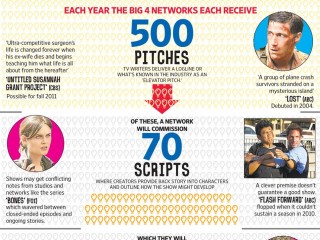According to The Wall Street Journal, between CBS, ABC, NBC and Fox, each season brings each major network approximately 500 pitches, followed by requests for 70 scripts, shoots for 20 pilots, and airings for 4 to 8. Only one or two make it to multiple seasons.
This shortage of content has multiple culprits: too many decision makers, not enough time to flourish, and too few networks. Historically speaking, some of the most popular shows on television didn’t have to beat these odds.
“Some shows end up coming out of the development process like a camel, a horse designed by committee,” says Jeff Melvoin, a veteran producer who worked on “Alias,” “Northern Exposure,” and “Hill Street Blues.” Mr. Melvoin now works on cable, which has smaller audiences and fewer demands, as an executive producer on “Army Wives.”
…
Networks analyze how ratings drop off during commercial breaks, a sign that viewers have sampled, and rejected, a series. Last month CBS pulled its spy comedy “Chaos” after three episodes. The debut episode opened with seven million viewers. After 15 minutes, 6.3 million were watching, according to Nielsen Co.
…
CBS, the top-ranked network in total prime-time viewers, limits the executives who offer input on new series. In addition to Chief Executive Leslie Moonves, “it’s me, it’s the head of the department, it’s the show runner. We don’t have committees,” [CBS Entertainment President Nina] Tassler says.
So, what’s wrong with the networks in finding more hits? Here are my off-the-cuff observations.
- Find a longer gestation period, even if it means moving the time slot. Promising shows live or die by brash decisions. “Freaks and Geeks,” for example, cancelled after just twelve episodes, was asked by its network to include Britney Spears as a waitress in one episode, according to Wikipedia. Producer Judd Apatow and others disagreed, but added Ben Stiller to one show. But it was too late, cancelled before it had a chance. Apatow, and much of the cast of the show, went on to produce very popular features instead. On the other hand, “Seinfeld” originally didn’t have Elaine; an exec said “add a woman” and the show survived.
- Reward passionate audiences with shows that cultivate fan bases. Look beyond Nielsen to embrace content beyond their DVD/BluRay market. The industry-standard survey ranks the top-rated series of the last ten years as “American Idol,” “CSI” and “Friends.” Rankings are calculated by diaries or scanners that weigh each minute of a program. However, cancelled shows with big followings to this date include “Arrested Development,” “Twin Peaks,” or “Firefly.”
- Value discussability. I know so many people who took to watching shows like “Lost” and “Mad Men” way after they first aired. People don’t just watch anymore, likely due to mediocre advertising to broad demographics. According to Mashable, other metrics such as social media reveal programs like “NCIS,” “Criminal Minds,” “Glee” and “House” were popular to discuss, which is worth something to someone. The article notes how “Glee” doesn’t make Nielsen’s Top 40, but continues to be renewed, after winning a Golden Globe and nearly 40 million viewers after the Super Bowl this last year, as noted on Wikipedia.



Got something to add?